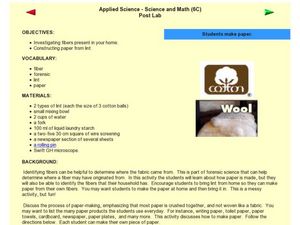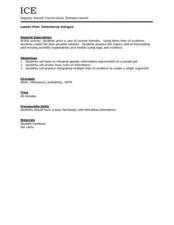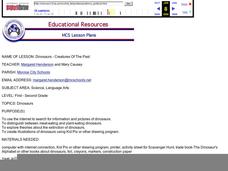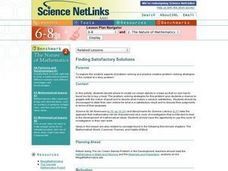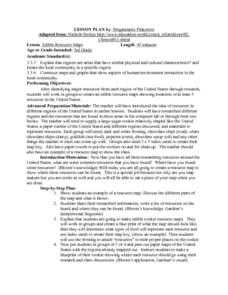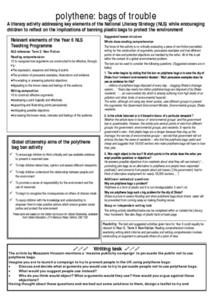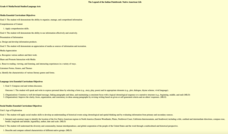Curated OER
Microscopes: Is what you see, what you got?
Eighth graders identify the parts and functions of the microscope. For this biology lesson, 8th graders observe different samples under different types of microscopes. They compare and contrast the details they see.
Curated OER
Applied Science - Science and Math (Post Lab)
Learners explore science. In this create science lesson, students come up with their own science experiment. They use their basic knowledge of hypothesis and procedure to come up with an experiment. This lesson includes background...
Curated OER
Inheritance Intrigue
Students slve a case of unclear heredity using three lines of evidence and knowledge gained from the lesson in this biology lesson about Mendelian inheritance. The lesson includes handouts and a question sheet for final, individual...
Curated OER
Cloudy With A Chance of Meatballs
Third graders use a variety of information resources to identify local environmental issues and examine the ways that people have tried to solve these problems. They read "Cloudy With A Chance of Meatballs" and create a list of three...
Curated OER
A Picture is Worth a Thousand Words
High schoolers examine the differences between the Euro coins and bills. As a class, they discuss importance of the images on the money and use the internet to research why they were selected. In groups, they design new bills with...
Curated OER
How Can You Study Things You Can’t See Like: Atoms?
Learners simulate how scientists studied things they can't see like atoms. In this chemistry lesson, students predict what is inside the numbered obsertainers. They design a way to investigate what's inside without opening it.
Curated OER
Have You Ever Wondered?
Students use their personal knowledge and the Internet to discover where and how spiders live. In groups, they discuss their experiences with spiders and how their lives differ from other insects. They use new vocabulary to discuss their...
Curated OER
Dinosaurs: Creatures of the Past
Students search for information and pictures of dinosaurs to distinguish between meat-eating and plant-eating dinosaurs. They explore theories about their extinction, and create illustrations of dinosaurs using Kid Pix or other drawing...
Curated OER
Land Use Issues
In this unit of lessons, students examine analogies and parts of speech. They use land use issues to identify the different parts of speech that they research. They create analogies about the origin of organisms.
Curated OER
Tony's Spelling Troubles
Students are introduced to the given problem and describe in their own words the situation represented in a bar chart and tally chart. They then use a bar chart and tally chart to make sensible predictions.
Curated OER
How Many Cards Do We Need to Display the Dates of the Month?
Students complete activities to study the concept of place value notation. In this place value instructional activity, students use cards for the days of the month that only number from 1 to 9. Students find a subtraction pattern to...
Curated OER
Finding Satisfactory Solutions
Students explore the creative aspects of problem-solving and practice creative problem-solving strategies in the context of a story problem. They decide where to locate ice cream stands in a town so that no one has to travel too far to...
Curated OER
Edible Resource Maps
Third graders work in groups to create an edible resource map showing locations of at least five resources in the United States. Students research on the internet different regions and the resources that are found in those areas. They...
Curated OER
Polythene: Bags Of Trouble
Students investigate the use of polythene bags in the community and measure the possible impact upon the environment. They conduct research using a variety of resources. The information is used in order to create an evaluative opintion...
Curated OER
Who Wants to be a Cellular Biologist?
Eighth graders review concepts in cellular biology. In this biology lesson, 8th graders play an interactive game based on the idea of winning money. They discuss misconceptions about the topic.
Curated OER
Creating a Salad Dressing
Pupils investigate how the scientific process can be applied to making a new salad dressing recipe.
Curated OER
Great Women Thinkers
Young scholars visit the Mary Baker Eddy museum. They discover the great women thinkers of the past. They make notes and observations during their visit and share them with the class.
Curated OER
Weather Systems
Fourth graders research weather phenomenon in groups on the Internet and create a slide for the class power point presentation. They include 5 key points (temperature, air pressure, and fronts and descriptions for each type of cloud or...
Curated OER
The Legend of the Indian Paintbrush: Native American Life
Pupils read," The Legend of the Indian Paintbrush" by Tomie dePaola and discuss the way legends are passed down orally. They then create their own legend and illustrate it on a simulated "Buffalo Skin" made from brown paper.
Curated OER
Sea Ice Research
Learners study sea ice and its importance in climate and climate change. They discuss sea ice as a presence of a food source for marine animals in the arctic and complete a lab activity. After completing the lab, they watch a video...
Curated OER
Brainstorming and Number Patterns
Ninth graders discover what it means to "brainstorm." They explore a given simple number pattern and then, working in groups, brainstorm more complicated number patterns. They display them around the room and then solve the number...
Curated OER
Science and the Scientific Process
Young scholars investigate the characteristics of different soil samples. In this physical science lesson, students play the role of forensics solving a crime by matching soil from the suspect's shoes. They formulate a conclusion after...
Curated OER
Water Cycle
Students answer short answer questions about the water cycle and other cycles. In this water cycle lesson plan, students explore clouds, rain, evaporation, and more.
Google
Google for Education: Writing a Story
In this activity, student storytellers write a story with each group member writing one chapter based on a set of story points. After all the members have come up with their chapters independently, the group collaborates to make the...



